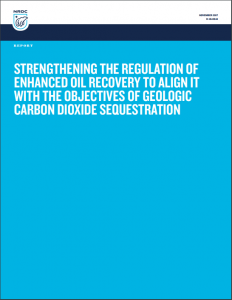Full Title: Strengthening The Regulation Of Enhanced Oil Recovery To Align It With The Objectives Of Geologic Carbon Dioxide Sequestration
Author(s): Briana Mordick & George Peridas
Publisher(s): Natural Resources Defense Council
Publication Date: November 1, 2017
Full Text: Download Resource
Description (excerpt):
Capturing carbon dioxide from large point sources—such as power plants and refineries—and permanently disposing of it in deep underground geologic formations through a set of technologies known as carbon capture and geologic sequestration (CCS) can complement the mainstay efforts to use energy more efficiently and to switch to renewable sources. Pursuing emission reductions through CCS can increase the chances of achieving our climate-mitigation targets, expedite the pace of reductions, and lower the overall cost of mitigation.
There are now 16 integrated CCS projects in North America alone that capture, transport, and sequester CO2 from a variety of sources, including fuel processing, power, fertilizer, and chemical plants, and several more around the world. However, many more will be needed if this technology is to contribute meaningfully to mitigating climate change.
A technique known as CO₂-Enhanced Oil Recovery (CO₂-EOR) offers a faster and more likely pathway to the deployment of CCS projects in the near and mid terms. Today, CO₂-EOR has gained sufficient attention in the public policy realm as a potential climate-mitigation, job-creation and energy-security option to merit closer regulatory scrutiny. The results of our in-depth analysis indicate that the potential for CO₂-EOR to function as a climate-mitigation technology—as opposed to purely an oil-extraction technique—is limited by flaws in the way geologic sequestration during CO₂-EOR is regulated and certified today. Improvements are needed that would provide the transparency and confidence needed to show that the injected CO₂ is indeed being stored permanently.
This report takes a close look at the existing regulatory structures for CO₂-EOR and current practices in the field, analyzes what does and does not work, and proposes a path forward that is environmentally sound, workable by operators, and credible by stakeholders and the public.
